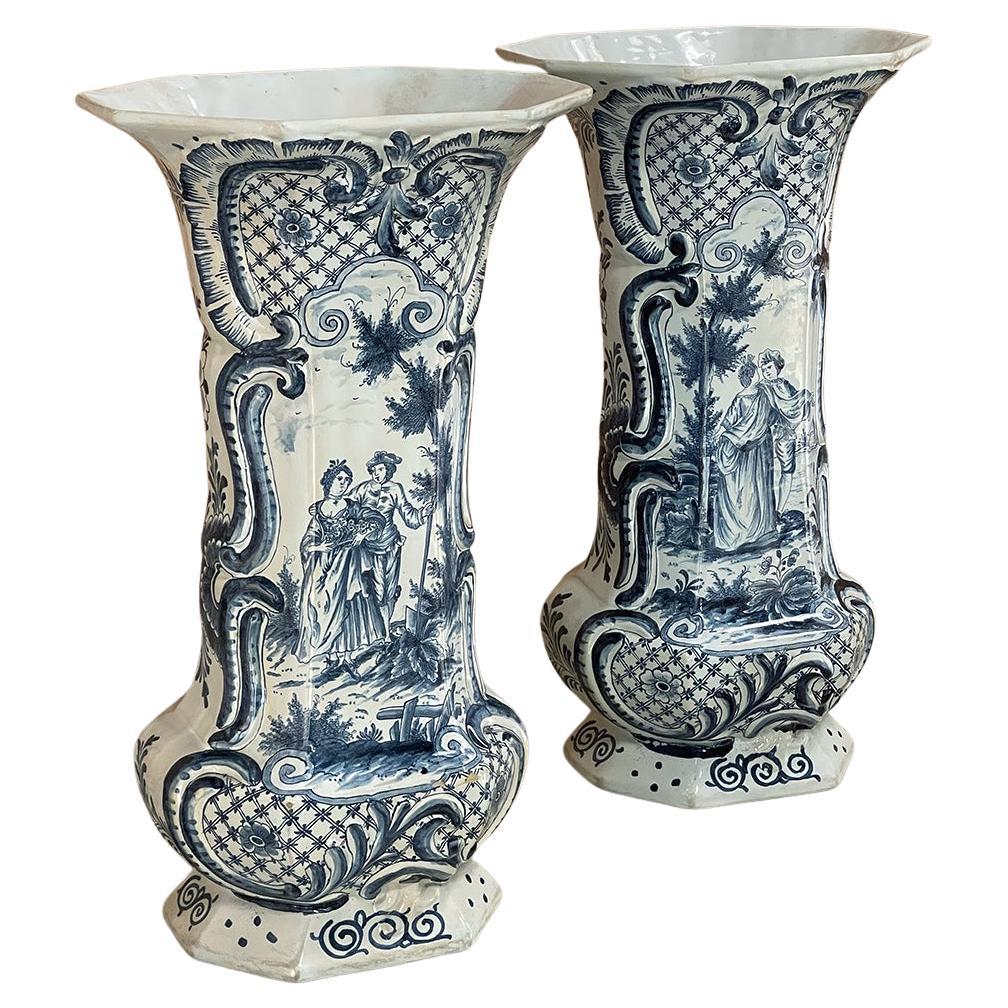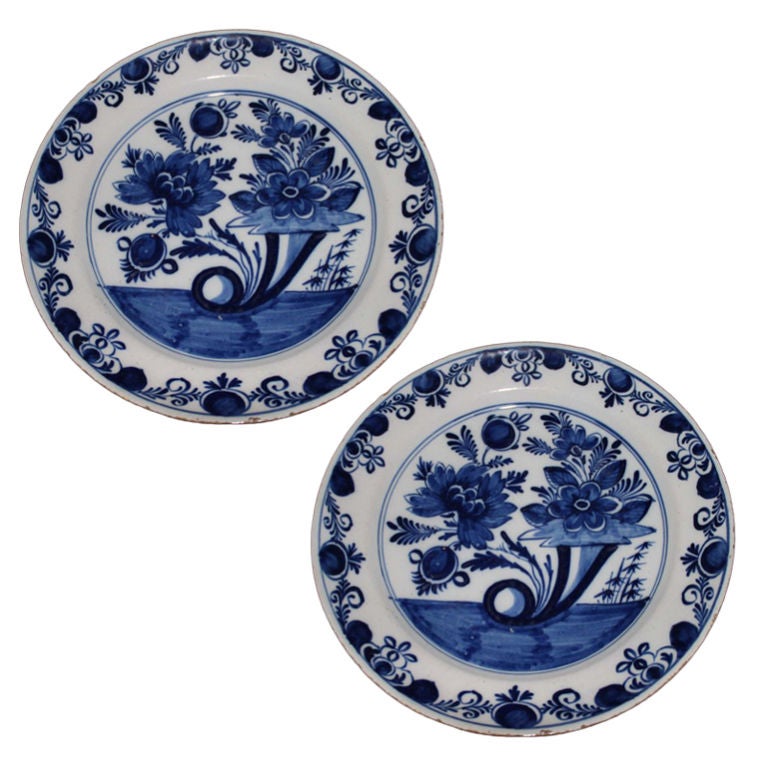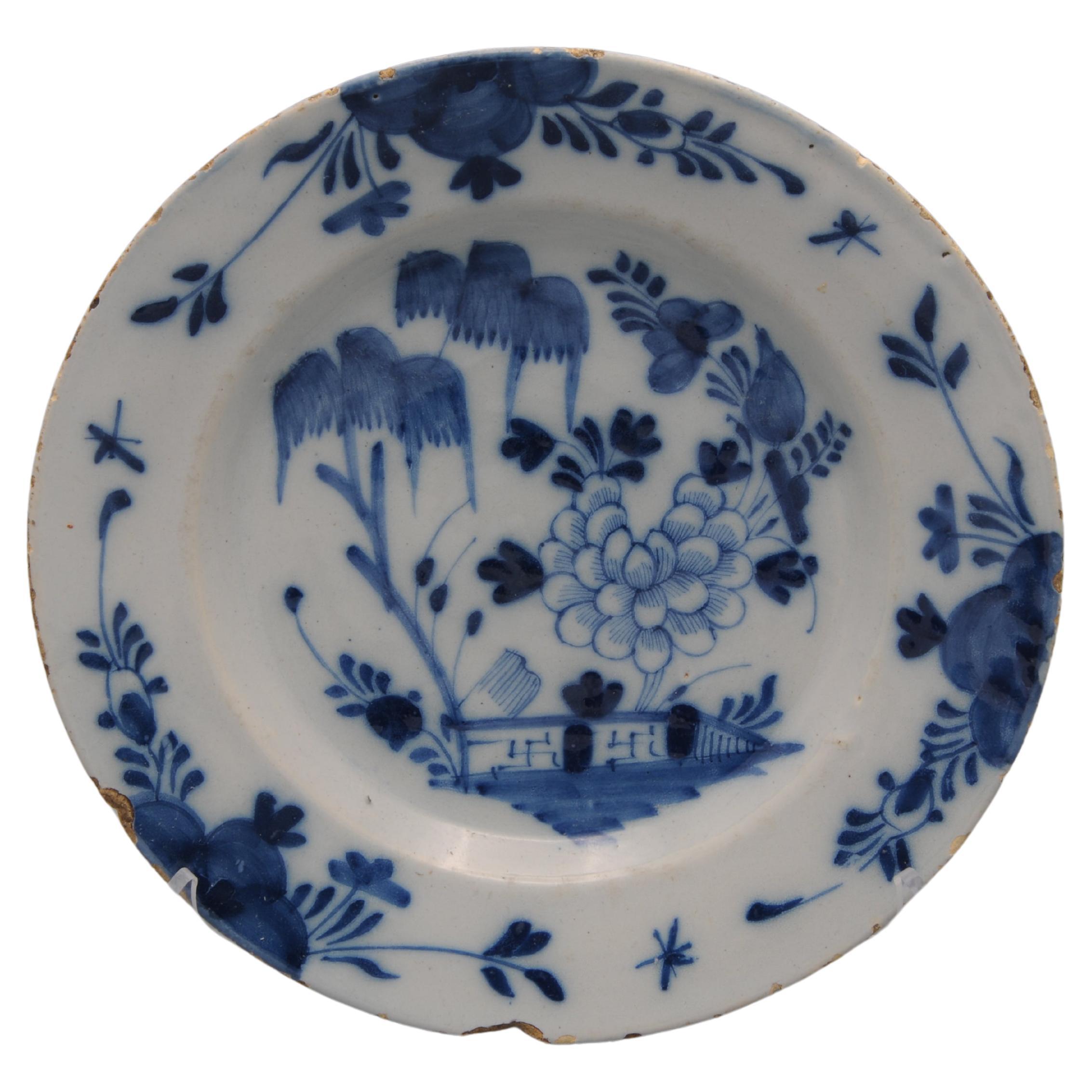Items Similar to Blue and White Delft Jars and Vases 18th and 19th Centuries 3 Pairs 4 Singles
Want more images or videos?
Request additional images or videos from the seller
1 of 9
Blue and White Delft Jars and Vases 18th and 19th Centuries 3 Pairs 4 Singles
About the Item
Background of Dutch Delft:
The technique of making Delft was first described in writing by Gerrit Paape in "The Delft Pottery Maker," written in 1794 and dedicated to Lambertus Sanderus, the owner of De Porceleyne Claeuw (The Porcelain Claw). Delft faience began in the 17th century. Much of the most beautiful Delft was produced in the Dutch city of Delft. The Delft potters began to coat their pots thoroughly in a white tin glaze. They then began to cover the white tin glaze with a clear glaze, giving depth to the fired surface and smoothness to cobalt blues. Over time they created a good resemblance to porcelain. By circa 1650, the technical skills of the potters and painters were much improved, and Delft began its golden age.
We offer FREE shipping to the continental United States. For orders shipping outside the continental US, please email for a shipping quote.
Buyer Protection Guarantee: your purchase will arrive as described.
Questions? Contact us.
- Dimensions:Height: 23.5 in (59.69 cm)Diameter: 11 in (27.94 cm)
- Sold As:Set of 10
- Style:Rococo (Of the Period)
- Materials and Techniques:
- Place of Origin:
- Period:
- Date of Manufacture:1780
- Condition:
- Seller Location:Katonah, NY
- Reference Number:Seller: SKU000006781stDibs: LU866534411792
About the Seller
5.0
Recognized Seller
These prestigious sellers are industry leaders and represent the highest echelon for item quality and design.
Platinum Seller
These expertly vetted sellers are 1stDibs' most experienced sellers and are rated highest by our customers.
Established in 1962
1stDibs seller since 2009
423 sales on 1stDibs
Typical response time: <1 hour
- ShippingRetrieving quote...Ships From: Katonah, NY
- Return PolicyA return for this item may be initiated within 30 days of delivery.
More From This SellerView All
- Pair Blue and White Delft jarsBy Boch Freres KeramisLocated in Katonah, NYThis pair of large Delft jars has a traditional blue and white floral decoration painted on a white tin-glazed ground. The body of each jar features four large panels; two show a pea...Category
Vintage 1920s Belgian Rococo Delft and Faience
MaterialsDelft
- Pair Blue and White Delft Tobacco Jars Netherlands 18th Century circa 1770Located in Katonah, NYThis outstanding pair of Dutch Delft blue and white tobacco jars were made circa 1770 to hold a type of tobacco named "DÜÎNKERKER." Made in the city of Delft circa 1770, the cobalt blue decoration on the jars is outstanding. Description: Framing the title of the jar is lovely floral decoration of leaves, small flowers, and scrolling vines. At the top of the floral decoration, we see a vase bursting with leaves and flowers. The covers are 20th century. Dimensions: 8.75" tall (11"with covers) x 7.25" diameter at widest point Condition: Excellent Price: $3,400 Provenance: One of the pair has the mark of The Blompot on the underside. The Blompot factory operated from 1654 until 1841. In addition, the Philadelphia Museum of Art has an almost identical tobacco jar made by a competing contemporary Dutch Delft factory. The museum notes the name on the jar, "DÜÎNKERKER," refers to a type of tobacco that was more commonly known as DÜÎNKERKEN, spelled with an "N" at the end. Duinkerken is a type of chewing tobacco. (For more details from the Philadelphia Museum of Art listing, see ** below). Background of Dutch Delft: The technique of making Delft was first described in writing by Gerrit Paape in "The Delft Pottery Maker," written in 1794 and dedicated to Lambertus Sanderus, the owner of De Porceleyne Claeuw (The Porcelain Claw). Delft faience began in the 17th century. Much of the most beautiful Delft was produced in the Dutch city of Delft. The Delft potters began to coat their pots thoroughly in a white tin glaze. They then began to cover the white tin glaze with a clear glaze, giving depth to the fired surface and smoothness to cobalt blues. Over time they created a good resemblance to porcelain. By circa 1650, the technical skills of the potters and painters were much improved, and Delft began its golden age. Background of 18th Century Tobacco Use in The Netherlands: Tobacco use in 18th century Holland was widespread and socially acceptable. It was commonly consumed through smoking in pipes. Pipe smoking became popular among all social classes, from the working class to the wealthy elite. Tobacco was not only enjoyed for its recreational purposes but also had a role in social rituals and gatherings. It was often smoked during social events, in coffeehouses, taverns, and at private gatherings. The Dutch Republic was known for its extensive trade networks, and tobacco was significant in this trade. The Dutch East India Company (VOC) was crucial in bringing tobacco from the colonies, such as Virginia in North America and Java in the East Indies. In addition, the VOC controlled much of the tobacco trade in Europe, contributing to the popularity and availability of tobacco in Holland. **The Philadelphia Museum of Art "Tobacco Jar and Cover 1764-1772 Made by De Porceleyne Schotel (The Porcelain Dish), Delft, Netherlands (1598–1791) Under Johannes van Duijn...Category
Antique Late 18th Century Dutch Delft and Faience
MaterialsDelft
- Pair Large Blue and White Delft Jars Made Netherlands 18th Century Circa 1780Located in Katonah, NYThis exquisite pair of 18th-century blue and white Delft jars are hand-painted in deep cobalt blue with an all-over design of flowers and scrolling vines. The jars are octagonal with...Category
Antique Late 18th Century Dutch Delft and Faience
MaterialsDelft
- Delft Blue and White Vase Hand Painted 18th Century circa 1780 NetherlandsLocated in Katonah, NYMade circa 1780, this 18th century Dutch Delft vase was hand painted with floral decoration of flowers and scrolling vines. A beautiful deep cobalt blue covers most of the surface....Category
Antique Late 18th Century Dutch Rococo Vases
MaterialsDelft
- Blue and White Delft Vase Hand Painted 18th Century Netherlands, circa 1760Located in Katonah, NYThis blue and white Delft jar was made in the Netherlands in the early 18th century, circa 1730. The jar is covered in a gorgeous light blue glaze traditional to much early 18th ce...Category
Antique Early 18th Century Dutch Rococo Vases
MaterialsDelft
- Blue and White Delft Mantle Jar Hand-Painted 18th Century Netherlands Circa 1780Located in Katonah, NYA blue and white Dutch Delft mantle jar hand-painted in exquisite deep cobalt blue. We see a peacock in a garden filled with flowers and ferns. The cover is similarly decorated a...Category
Antique Late 18th Century Dutch Chinoiserie Delft and Faience
MaterialsDelft
You May Also Like
- Pair 18th Century Delft Blue & White VasesLocated in Dallas, TXPair 18th century delft blue & white vases are of a type that is getting more rare with each passing year. Alas, the fragile nature of such han...Category
Antique Late 18th Century Dutch Dutch Colonial Vases
MaterialsCeramic
- Plates Pair Delft Blue and White 18th Century HollandLocated in New York, NYPlates Pair Delft Blue and White 18th Century Holland. A pair of beautiful large delft plates decorated with blue and white flowers made during the ...Category
Antique 18th Century Dutch Rococo Delft and Faience
MaterialsDelft
- Delft - 18th century 'Chinoiserie' Blue and White Delft PlateBy DelftLocated in DELFT, NLDutch Delft blue and white plate with a 'Chinoiserie' decoration of a landscape with a fence, flowering peony and willows. Good condition: light chipping and some usual wear to the...Category
Antique Early 18th Century Dutch Chinoiserie Delft and Faience
MaterialsEarthenware, Delft, Faience
- Early 18th Century Blue and White Dutch Delft Clobbered VaseLocated in Fort Lauderdale, FLA blue and white Dutch delft vase made circa 1700, with clobbered-style polychrome enamels added in the mid-18th century. This brightly colored blue and white Dutch delft vase is a ...Category
Antique Early 18th Century Dutch Dutch Colonial Vases
MaterialsDelft, Pottery
- Blue and White Dutch Delft Lidded Jar in Chinoiserie, Early 18th CenturyBy DelftLocated in AMSTERDAM, NHAn Early Dutch Delftware lidded jar with chinoiserie decoration. Origine: Delft, The Netherlands Date: Early 18th century Workshop: Unknown. A genuine blue and white lidded j...Category
Antique Early 18th Century Dutch Chinoiserie Delft and Faience
MaterialsCeramic, Delft, Faience
- 18th-19th Century Polychrome Delft PlatterLocated in Charleston, SC18th-19th century polychrome delft platter.Category
Antique 19th Century Dutch Delft and Faience
MaterialsEarthenware
Recently Viewed
View AllMore Ways To Browse
Cobalt Blue Charger
Delft Windmill
Vintage Delft Blue Pottery
Large Delft Bowl
18th Century Delft Urn
Delft Mugs
Nevers Faience Plate
Antique Delft Figurines
Delft Mug Hand Painted
Dutch Silver Beaker
20th Century Delft Figurines
Antique Metal Wash Basin
Keller Scroll Furniture
Majolica Wedges
De Hooch
17th C Delft Tiles
Indigo Isle
Mbfa Pornic





